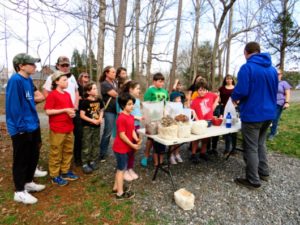 by Jessica Frierson, March 2023
by Jessica Frierson, March 2023
In last week’s blog post, I wrote about what the homeschooling parent needs. This week I will look at the five needs of the homeschooled child. You may expect those needs to include Internet access, a study area, the best curriculum you can afford, and items such as that. Those things might be useful but are by no means necessary. Of far greater importance are these vital elements that each child needs.
1. Love
The most basic need of every human being is to be loved. We could assume that the child whose parents are willing to invest the time, money, and effort into homeschooling should know that they are loved. After all, why would we go to all of that trouble if we didn’t even love them, right? However, just as we all need to be loved, we also all need those who love us to take the extra steps to tell us, show us, and reassure us of their love.
In the homeschool situation, Mom and/or Dad take on a new role in the child’s life. This new role gives us opportunities to show our love to our child in additional ways, but it can also create areas of vulnerability. You may have heard about the five love languages that we all speak: words of affirmation, receiving gifts, acts of service, quality time, and physical touch. Learning which of these areas is the way that your child perceives love from others can be very helpful in building your relationship with your child and help you avoid unintentionally speaking the wrong message to them. For example, if your child’s love language is words of affirmation, you will want to be particularly careful as you teach your child that your words of correction are clearly directed at their schoolwork and are accompanied by words of praise and encouragement.
A child whose love language is touch will thrive in the homeschool environment that allows for lots of snuggling, sitting on Mom’s lap while she reads, and plenty of hugging throughout the day. Similarly, homeschooling provides ample room for sharing quality time together and doing acts of service for your child. And the child who feels the most loved when given gifts will have their love tank filled up when you purchase a special pack of pencils, a new notebook with a cute cover, or some other small token to brighten their day.
This is in stark contrast to what many children experience when they leave their home each day for a classroom. One of the top reasons parents choose homeschooling is to remove their children from an environment where they have been bullied. The peer pressure that children face at a school wears away at their self-esteem. There is a constant demand to fit in, to measure up, and to be accepted. It is a rare occurrence for a child in a traditional school setting to feel loved there. Because of this, if you are bringing your child out of the classroom setting to begin homeschooling, you may want to consider a period of deschooling before beginning formal book work so that you can replenish their depleted “love tank” and shift their approach to learning.
2. Confidence
A child who is loved has the seeds of confidence planted within them. Home education is like a greenhouse where those seeds can sprout and flourish in a secure environment designed to meet their individual needs. Confidence is quickly squashed in a traditional classroom, where each child is expected to learn at the same speed, in the same manner, as every other child in the class. When learning at home, they can move at their own pace, moving on quickly when they understand the material and taking more time on subjects that aren’t as easily comprehended.
Like many home educators, I see no need to give grades on schoolwork that my children do until the high school years when grades are necessary for their transcript. I guide them through correcting their mistakes, and when I feel that they understand the concept, move on to the next one. Likewise, I have no use in our homeschool for grade levels. When a child completes one book, they start the next one. Therefore, they may be in a variety of grade levels depending on the subject. This builds confidence in them, encouraging them to try new things and to keep moving forward. If they get many problems incorrect on their math assignment, they know they need to talk to me about the lesson so that they can understand it, not so that they can get a more pleasing grade.
Just as I said that a child transitioning from a traditional classroom to homeschooling may need their love tank to be replenished, they may also need to have their confidence boosted. Particularly if they have been struggling learners, you will need to look for ways to help them believe that they CAN learn, that they ARE good enough, and that they are NOT stupid.
3. Vision
Once a child feels confident about their ability to learn, they begin to think about the possibilities ahead. A vision for their future develops. It may be the near future (learning to fly a drone) or further down the road (wanting to be a pilot). They may show curiosity about a particular subject, such as astronomy, cooking, World War II, or NASCAR racing. If you incorporate these sparks of interest into your lesson plans, you may light the fire under a future astronaut, chef, foreign policy advisor, or pit crew member. More likely, you will help your child get excited about learning, teach them to become self-motivated, and encourage them to explore new ideas. You can then work with them to create an education plan suited to their aspirations. Together, you can set goals that will move them along the path to graduation and their life beyond their school years.
I found with my children that once they grasped the concept that the point in learning what I was teaching them in school was to enable them to do the things they’ll want to do when they are adults, their whole attitude about school changed. They may have still disliked writing essays or carefully following each step of the scientific method to conduct an experiment, but they at least understood that there was something to be gained by giving it their best effort. Having a vision for what they could achieve motivated them to learn.
4. Resources
Many new homeschoolers focus on curriculum as the most crucial need in a homeschool. However, if the previous three needs are lacking, the effectiveness of the resources you use will be diminished. The child who is secure in feeling loved, has confidence in his ability to learn, and has a vision for what he wants to achieve can make use of virtually any material available. Fortunately, there is a plethora of materials to choose from.
As I wrote last week, a good starting point is to determine which approach to homeschooling suits your family and what each child’s unique learning style is. Then you can look for a curriculum that meets those criteria. Don’t be afraid to mix it up with books from various publishers. If appropriate, let your child help you select some of their school subjects and the books they’ll use to study each subject. For example, you might give them the option of studying botany, marine biology, or earth science. Ask if they would like to learn about the Roman Empire or the explorers of the New World. You could pick out books from the public library on those subjects or purchase a curriculum that covers it.
The resources you use in your homeschool are not limited to books. One of the most valuable resources is people. An uncle who is a history buff, a neighbor that fought in Vietnam, a friend who teaches math… these are treasures to add to your homeschool plan! Another is locations — local museums, science centers, historical landmarks, even businesses that may be surprising points of interest. We have gone on field trips with our small homeschool group to a nearby dairy, a soap-maker, a mushroom farm, and an electric power plant. I could write an entire blog post for each one of these outings detailing what the kids learned. Children will remember more from what they get involved in than when they only read material and feed back answers.
5. Community
Humans also have a need for being with each other; they need to be part of a community. What that community looks like will vary greatly from family to family. For many years, we had a large extended family close by so my children always had cousins to play with, learn new ideas from, and develop social skills from. A homeschool co-op or support group may offer enrichment classes for your child, academic opportunities such as science fair, debate club, or spelling bees, and social activities like park days, dances for high school students, or a book club, and may even provide team sporting activities. Church, 4-H, scouting, Civil Air Patrol or JROTC, and homeschool sport teams are additional segments of your community that may appeal to your family.
Being part of a community of some type helps your child learn how to interact with others and develop strong social skills such as conflict resolution, how to earn and show respect, active listening, and effective communication. These skills are best learned from a mix of ages and under their parent’s oversight, which is why homeschool parents laugh at the commonly asked question of how homeschooled children will learn socialization. Good socialization skills are not honed well on the school playground or in a classroom filled with twenty other kids of the same age. The homeschooled child learns patience while waiting for their mother to finish caring for their baby sibling, compassion when visiting an elderly friend at the nursing home, and dependability when they help plan events with other homeschool families.
The greatest needs that the homeschooled child has are not dependent on the size of the family’s bank account or the education level of the teaching-parent. Any parent can provide these five crucial components. Our goal at NCHE is to help you homeschool with confidence and joy. We are here to provide you with the support and resources you need to succeed in this endeavor. Please reach out to us today if there is anything you need!
 Jessica Frierson is a second-generation homeschooler. She is married to Ernie, a retired minister. They have been homeschooling their seven sons and three daughters since 2000. She is a speaker and writer. She serves as the secretary for NCHE, writes for GREENHOUSE, and is the lead blogger for the NCHE blog.
Jessica Frierson is a second-generation homeschooler. She is married to Ernie, a retired minister. They have been homeschooling their seven sons and three daughters since 2000. She is a speaker and writer. She serves as the secretary for NCHE, writes for GREENHOUSE, and is the lead blogger for the NCHE blog.
All photos by Jessica Frierson.









